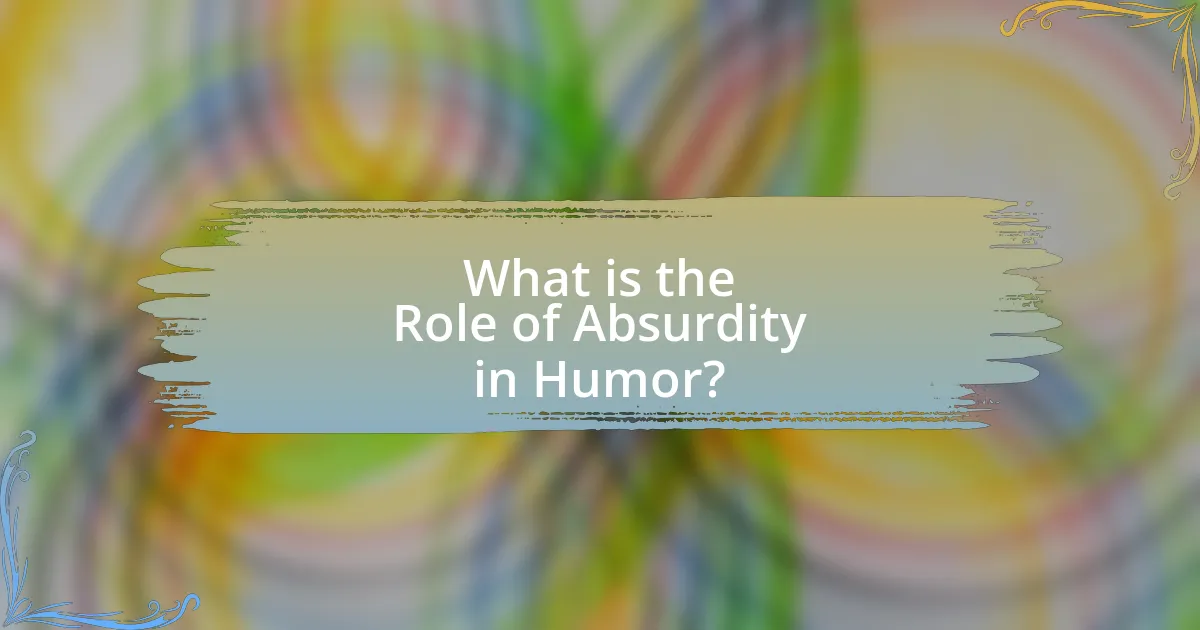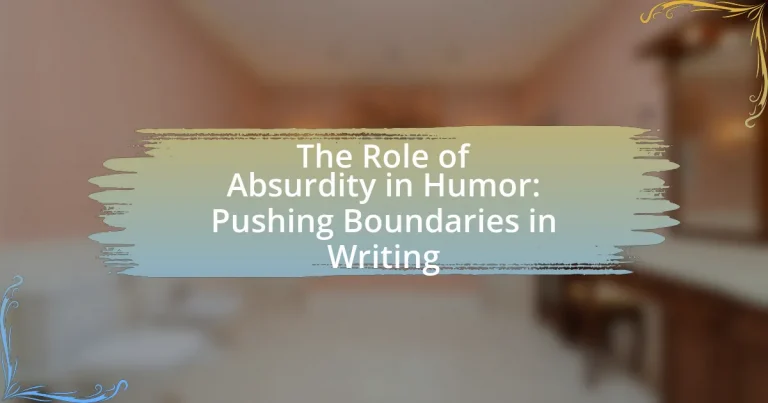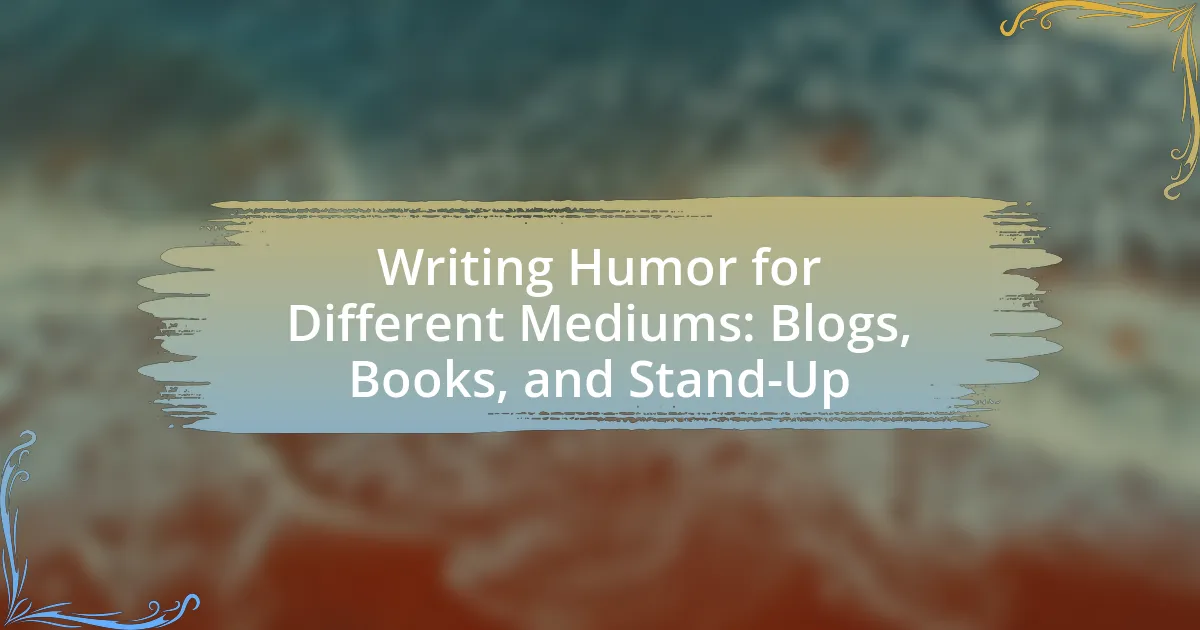The article explores the role of absurdity in humor, highlighting its significance in subverting expectations and creating incongruity that elicits laughter. It examines how absurdity enhances the effectiveness of humor through illogical scenarios, exaggerated characters, and unexpected twists, while also challenging conventional norms. The psychological effects of absurdity, including increased cognitive flexibility and creativity, are discussed alongside historical examples and cultural variations in comedic traditions. Additionally, the article provides practical techniques for writers to effectively incorporate absurdity into their work, emphasizing the balance between coherence and absurdity in storytelling.

What is the Role of Absurdity in Humor?
Absurdity plays a crucial role in humor by subverting expectations and creating incongruity, which elicits laughter. This form of humor often relies on illogical scenarios or exaggerated situations that challenge conventional reasoning, making the unexpected outcomes amusing. For instance, the works of comedians like Monty Python exemplify how absurdity can transform mundane situations into comedic gold through surreal and nonsensical elements. Research indicates that humor derived from absurdity can enhance cognitive flexibility, allowing individuals to appreciate humor that deviates from normal patterns of thought.
How does absurdity contribute to the effectiveness of humor?
Absurdity enhances the effectiveness of humor by creating unexpected and illogical scenarios that challenge conventional thinking. This element of surprise disrupts the audience’s expectations, leading to laughter as a response to the incongruity. Research by Thomas Veatch in “A Theory of Humor” suggests that humor arises from the recognition of absurdity, as it prompts cognitive dissonance that the brain resolves through amusement. Thus, absurdity serves as a catalyst for humor by leveraging the unexpected to elicit a strong emotional reaction.
What are the key elements of absurdity in comedic writing?
The key elements of absurdity in comedic writing include illogical scenarios, exaggerated characters, and unexpected twists. Illogical scenarios disrupt conventional reasoning, creating humor through surprise and confusion. Exaggerated characters amplify traits to an extreme, making their actions and dialogues inherently funny. Unexpected twists subvert audience expectations, leading to humor derived from the unpredictability of outcomes. These elements collectively challenge norms and provoke laughter by presenting the absurdity of situations and human behavior.
How does absurdity challenge conventional norms in humor?
Absurdity challenges conventional norms in humor by subverting expectations and creating incongruity that defies logical reasoning. This form of humor often employs nonsensical scenarios, unexpected juxtapositions, and illogical conclusions, which disrupt the audience’s preconceived notions of what is funny. For instance, the works of comedians like Monty Python and writers like Franz Kafka illustrate how absurdity can provoke laughter by presenting bizarre situations that highlight the absurdity of everyday life. Research in psychology indicates that humor derived from absurdity can enhance cognitive flexibility, allowing individuals to appreciate humor that deviates from traditional comedic structures.
Why is absurdity considered a boundary-pushing element in writing?
Absurdity is considered a boundary-pushing element in writing because it challenges conventional logic and societal norms, allowing writers to explore themes and ideas that provoke thought and elicit humor. By presenting illogical scenarios or characters, absurdity disrupts readers’ expectations, encouraging them to reconsider their perceptions of reality. This technique has been effectively utilized by authors such as Franz Kafka and Samuel Beckett, whose works exemplify how absurdity can reveal deeper truths about the human condition and societal absurdities.
What historical examples illustrate the use of absurdity in humor?
Historical examples illustrating the use of absurdity in humor include the works of the playwright Eugène Ionesco, particularly in his play “The Bald Soprano,” which showcases nonsensical dialogue and illogical situations to highlight the absurdity of everyday life. Additionally, the Dada movement in the early 20th century, characterized by its rejection of logic and embrace of chaos, produced absurdist art and performances that challenged conventional norms, exemplified by Marcel Duchamp’s “Fountain,” a urinal presented as art. These instances demonstrate how absurdity serves as a powerful tool in humor, allowing for critique and reflection on societal norms.
How have different cultures embraced absurdity in their comedic traditions?
Different cultures have embraced absurdity in their comedic traditions through unique forms of humor that challenge societal norms and expectations. For instance, the Japanese tradition of “manzai” employs rapid-fire dialogue filled with puns and nonsensical situations, often highlighting the absurdity of everyday life. In contrast, the British use of absurdity is exemplified in works like Monty Python’s “Flying Circus,” which features surreal sketches that defy logic and conventional storytelling. Similarly, the Russian literary tradition, particularly in the works of authors like Daniil Kharms, showcases absurdist humor that critiques the absurdities of Soviet life. These examples illustrate how various cultures utilize absurdity to reflect on and critique their social realities, making humor a powerful tool for commentary and connection.

What are the Psychological Effects of Absurdity in Humor?
The psychological effects of absurdity in humor include enhanced cognitive flexibility, increased creativity, and improved coping mechanisms for stress. Absurd humor challenges conventional thinking, prompting individuals to reevaluate their perspectives and embrace unconventional ideas. Research indicates that exposure to absurdity can stimulate divergent thinking, which is crucial for creativity, as shown in studies by Koestler (1964) in “The Act of Creation,” where he discusses how humor can facilitate innovative thought processes. Additionally, absurd humor serves as a coping strategy, allowing individuals to confront and alleviate anxiety by reframing distressing situations in a humorous light, as supported by findings from Martin (2007) in “The Psychology of Humor: An Integrative Approach.”
How does absurdity affect audience perception and reaction?
Absurdity significantly alters audience perception and reaction by challenging conventional logic and expectations. When presented with absurd scenarios, audiences often experience confusion, which can lead to heightened engagement as they seek to understand the underlying humor or message. Research indicates that humor derived from absurdity activates the brain’s reward centers, enhancing enjoyment and laughter. For instance, a study published in the journal “Cognitive Processing” by authors such as Ruch and Hehl demonstrates that absurd humor can elicit stronger emotional responses compared to more straightforward comedic forms. This engagement often results in a memorable experience, as audiences are drawn to the unexpected twists and turns that absurdity introduces.
What role does surprise play in the humor derived from absurdity?
Surprise is a crucial element in the humor derived from absurdity, as it creates an unexpected twist that challenges conventional logic. This unexpectedness often leads to laughter because it disrupts the audience’s expectations, prompting a cognitive reevaluation of the situation. For instance, in absurdist literature, characters may find themselves in bizarre scenarios that defy normal reasoning, such as a talking dog giving life advice. This incongruity between the expected and the actual outcome elicits humor, as seen in works by authors like Franz Kafka and Samuel Beckett, where the absurdity of the situation is heightened by surprising elements that provoke both confusion and amusement.
How can absurdity evoke emotional responses in audiences?
Absurdity can evoke emotional responses in audiences by challenging their expectations and provoking surprise, laughter, or discomfort. When presented with illogical or nonsensical scenarios, audiences experience a cognitive dissonance that can lead to heightened emotional reactions. For example, in the realm of theater, plays like Samuel Beckett’s “Waiting for Godot” utilize absurdity to elicit feelings of existential angst and humor simultaneously, demonstrating how the unexpected can resonate deeply with viewers. This interplay between absurdity and emotion is supported by psychological studies indicating that humor derived from absurdity activates the brain’s reward centers, reinforcing the emotional impact.
Why do writers choose to incorporate absurdity into their work?
Writers choose to incorporate absurdity into their work to challenge conventional thinking and provoke thought. By presenting illogical scenarios or characters, writers can highlight the absurdities of real life, encouraging readers to question societal norms and expectations. For instance, the works of authors like Franz Kafka and Samuel Beckett exemplify how absurdity can reflect existential themes, illustrating the human condition’s inherent chaos and unpredictability. This technique not only entertains but also invites deeper reflection on the nature of reality and human experience.
What are the creative benefits of using absurdity in storytelling?
The creative benefits of using absurdity in storytelling include enhanced engagement, the ability to challenge societal norms, and the promotion of imaginative thinking. Absurdity captivates audiences by presenting unexpected scenarios that provoke laughter and curiosity, thereby increasing their emotional investment in the narrative. Additionally, absurd elements can subvert conventional expectations, allowing writers to critique social issues and explore complex themes in a more accessible manner. For instance, works like “Waiting for Godot” by Samuel Beckett illustrate how absurdity can convey profound existential themes while entertaining the audience. This dual function of absurdity not only enriches the storytelling experience but also encourages readers to think critically about the underlying messages.
How does absurdity allow for greater freedom in character development?
Absurdity allows for greater freedom in character development by breaking conventional norms and expectations, enabling characters to act in unpredictable ways. This unpredictability fosters creativity, as writers can explore diverse personality traits and motivations without being constrained by realism. For instance, in works like “Waiting for Godot” by Samuel Beckett, characters exhibit illogical behavior that reveals deeper existential themes, showcasing how absurdity can lead to profound character insights. Such freedom encourages the exploration of complex human emotions and relationships, ultimately enriching the narrative.

What Techniques Can Writers Use to Effectively Employ Absurdity?
Writers can effectively employ absurdity by utilizing techniques such as exaggeration, incongruity, and surrealism. Exaggeration amplifies characteristics or situations to an extreme degree, creating humor through the ridiculousness of the scenario. Incongruity involves placing elements together that do not logically fit, leading to unexpected and humorous outcomes. Surrealism introduces bizarre and dream-like elements that challenge reality, allowing readers to engage with the absurd in a thought-provoking manner. These techniques have been used by authors like Franz Kafka and Lewis Carroll, who exemplified the power of absurdity in their works, demonstrating its effectiveness in eliciting laughter and reflection.
How can writers balance absurdity with coherence in their narratives?
Writers can balance absurdity with coherence in their narratives by establishing a clear internal logic that governs the absurd elements. This approach allows readers to engage with the narrative while accepting the unconventional aspects. For instance, in works like “Alice’s Adventures in Wonderland” by Lewis Carroll, the absurdity is grounded in a whimsical yet consistent world where characters and events follow their own set of rules, making the narrative coherent despite its surreal nature. By maintaining this internal consistency, writers can create a framework that supports absurdity, ensuring that readers remain oriented and invested in the story.
What are some common pitfalls to avoid when using absurdity in humor?
Common pitfalls to avoid when using absurdity in humor include losing coherence, alienating the audience, and over-relying on shock value. Losing coherence occurs when the absurd elements do not connect logically, making it difficult for the audience to follow the humor. Alienating the audience can happen if the absurdity is too niche or esoteric, leaving many people confused rather than amused. Over-relying on shock value can diminish the effectiveness of humor, as audiences may become desensitized to extreme absurdity, reducing its impact. These pitfalls highlight the importance of balance and audience awareness in crafting effective absurd humor.
How can timing enhance the impact of absurdity in comedic writing?
Timing enhances the impact of absurdity in comedic writing by strategically placing unexpected elements to maximize surprise and humor. Effective timing allows writers to build anticipation, creating a rhythm that amplifies the absurdity when it finally occurs. For instance, a well-timed punchline can transform a bizarre scenario into a memorable comedic moment, as seen in classic sitcoms where the setup leads to an unexpected twist that catches the audience off guard. Research indicates that comedic timing is crucial for eliciting laughter, as it aligns with the brain’s processing of humor, making the absurdity more relatable and engaging.
What are some examples of successful works that utilize absurdity?
Some examples of successful works that utilize absurdity include “Waiting for Godot” by Samuel Beckett, “The Hitchhiker’s Guide to the Galaxy” by Douglas Adams, and the television show “Monty Python’s Flying Circus.” “Waiting for Godot” presents two characters waiting for someone who never arrives, highlighting the absurdity of existence. “The Hitchhiker’s Guide to the Galaxy” features bizarre scenarios and nonsensical logic, such as the concept of a towel being the most important item in the universe. “Monty Python’s Flying Circus” employs surreal sketches that defy conventional narrative structures, showcasing absurd humor through unexpected twists and illogical situations. These works effectively illustrate how absurdity can challenge traditional storytelling and provoke thought while entertaining audiences.
Which authors are known for their use of absurdity in humor?
Authors known for their use of absurdity in humor include Franz Kafka, Samuel Beckett, and Douglas Adams. Kafka’s works, such as “The Metamorphosis,” illustrate absurdity through surreal situations and existential themes. Beckett’s “Waiting for Godot” employs absurdity to explore the human condition, emphasizing the illogical nature of existence. Douglas Adams’ “The Hitchhiker’s Guide to the Galaxy” combines absurdity with science fiction, creating humor through bizarre scenarios and nonsensical dialogue. These authors effectively utilize absurdity to challenge conventional narratives and provoke thought.
How have films and television shows effectively showcased absurd humor?
Films and television shows have effectively showcased absurd humor by employing illogical scenarios, exaggerated characters, and unexpected twists that defy conventional storytelling. For instance, shows like “Monty Python’s Flying Circus” and “The Office” utilize surreal situations and deadpan delivery to create humor that challenges audience expectations. The absurdity in these narratives often highlights the ridiculousness of everyday life, making the humor relatable yet bizarre. Additionally, films such as “The Big Lebowski” incorporate nonsensical plotlines and eccentric characters, reinforcing the effectiveness of absurd humor in engaging viewers. This approach not only entertains but also encourages audiences to embrace the unpredictability of life, demonstrating the power of absurdity in comedic storytelling.
What practical tips can writers follow to incorporate absurdity into their humor?
Writers can incorporate absurdity into their humor by embracing illogical scenarios and unexpected twists. This can be achieved by creating characters who react in bizarre ways to ordinary situations, such as a person who insists on wearing a fruit costume to a formal event, highlighting the contrast between the expected behavior and the absurdity of the situation. Additionally, employing hyperbole can amplify the absurdity, such as exaggerating a minor inconvenience into a catastrophic event, like a spilled drink leading to a city-wide disaster. Furthermore, writers should play with language and puns, using nonsensical phrases that challenge conventional meanings, which can evoke laughter through surprise. These techniques are supported by the comedic principles outlined in works like “The Comic Toolbox” by John Vorhaus, which emphasizes the effectiveness of absurdity in eliciting humor.





